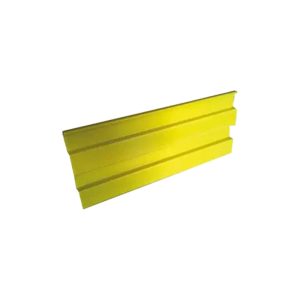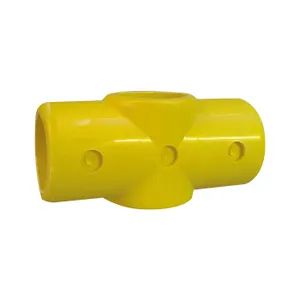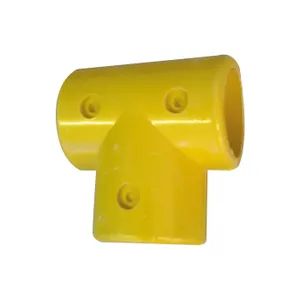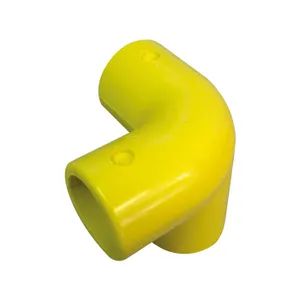ระบบราวจับ GRP ของเรามักใช้ในราวจับหรือราวกั้น GRP เพื่อต่อรางกลางไว้ที่มุม 90° หรือเชื่อมต่อเสาแนวตั้งกับรางด้านบน หรือเพื่อต่อราวกลางเข้ากับเสาส่วนท้าย
การแนะนำประสิทธิภาพของผลิตภัณฑ์
|
|
อุปกรณ์หมุนภายนอก GRP เป็นอุปกรณ์ข้อต่อแบบหมุนอินไลน์อเนกประสงค์ ซึ่งมักใช้โดยที่มุมจะแตกต่างกันไปตามทางลาด ขั้นบันได และการลงจอด |
|
มุมกลาง GRP 116 เป็นข้อต่อเข้ามุม 90° ซึ่งมักใช้ในราวจับหรือราวกั้น GRP เพื่อต่อรางกลางที่มุม 90° แต่ก็สามารถใช้สร้างโครงสร้างสี่เหลี่ยมหรือสี่เหลี่ยมได้เช่นกัน เหล็กตรงผ่านแนวตั้งผ่านข้อต่อ GRP มักใช้กับมุมบน GRP-128 |
|
|
ข้อต่อสามทางสั้น GRP 101 เป็นข้อต่อตัวที 90° โดยทั่วไปใช้ในราวจับ GRP เพื่อเชื่อมต่อเสาแนวตั้งกับรางด้านบน หรือเพื่อเชื่อมต่อรางกลางเข้ากับเสาส่วนท้าย ไม่สามารถต่อท่อเข้ากับด้านบนของข้อต่อได้ - สามารถใช้ข้อต่อสามทางยาว GRP-104 เป็นทางเลือกอื่นได้ หากจำเป็น |
|
GRP Fitting 119 Midrail Cross เป็นข้อต่อ 90° ซึ่งมักใช้เชื่อมต่อรางกลางกับเสาตั้งตรงตรงกลางในราวจับหรือราวกั้น GRP เหล็กตรงผ่านแนวตั้งผ่านข้อต่อ GRP |
|
|
GRP 104 Long Tee เป็นข้อต่อที 90° โดยทั่วไปจะใช้เพื่อเชื่อมต่อเสาแนวตั้งกับรางด้านบนของราวจับ GRP สามารถใช้ GRP -104 โดยต้องต่อท่อยาวสองเส้นไว้ที่ด้านบนของข้อต่อ |
|
ข้อต่อ GRP 125 มีข้อศอก 90° มักใช้ในราวจับหรือราวกั้น GRP เพื่อเชื่อมต่อรางด้านบนเข้ากับเสาตั้งตรงเมื่อสิ้นสุดระยะวิ่ง |
|
|
GRP 129 เป็นข้อต่อที 30° มักใช้กับราวบันไดหรือราวกั้น GRP |
|
ข้อต่อเข้ามุมบน 128 เป็นแบบ 3 ทาง ข้องอ 90° โดยทั่วไปจะใช้เพื่อต่อเสาตั้งตรงเข้ากับรางด้านบนของราวจับ GRP ที่มุม 90° มักใช้กับ GRP-116 Mid Corner |
|
|
GRP 130 เป็นไม้กางเขน 30° มักใช้เพื่อเชื่อมต่อราวกลางกับเสาตรงกลางในราวบันได GRP |
|
มุมกลาง GRP 116 เป็นข้อต่อเข้ามุม 90° ซึ่งมักใช้ในราวจับหรือราวกั้น GRP เพื่อต่อรางกลางที่มุม 90° แต่ก็สามารถใช้สร้างโครงสร้างสี่เหลี่ยมหรือสี่เหลี่ยมได้เช่นกัน เหล็กตรงผ่านแนวตั้งผ่านข้อต่อ GRP มักใช้กับมุมบน GRP-128 |
|
|
แผ่นฐาน GRP 132 เป็นหน้าแปลนฐานที่มีรูยึดสี่รู ใช้สำหรับยึดเสาตั้งตรงในราวจับหรือราวกั้น |
|
GRP 173 Single Swivel เป็นข้อต่อแบบหมุนได้อเนกประสงค์ ซึ่งใช้ในกรณีที่มุมแตกต่างกันไปตามทางลาด ขั้นบันได และทางลง |
|
|
เต้ารับติดผนัง 145 เป็นข้อต่อ GRP ที่ออกแบบมาเพื่อยึดราวจับ GRP หรือราวกั้นด้านข้างกับผนัง ทางลาด และขั้นบันได |  |
แผ่นรองเตะ GRP ของเรากว้าง 100 มม. และมีผนัง 5 มม. มีความยาว 6 เมตร แต่สามารถตัดให้ยาวได้หากต้องการ |
ผลิตในประเทศจีน พลาสติกเสริมแก้ว (GRP) ระบบราวจับ GRP ของ TFcomposite ให้ประโยชน์ที่สำคัญมากกว่าเหล็ก ซึ่งอธิบายว่าทำไมคุณจึงเห็นราวจับ GRP ทุกที่ ตั้งแต่งานบำบัดน้ำไปจนถึงอุตสาหกรรมราง
Fiberglass Reinforced Plastic (FRP) handrail systems are advanced, durable solutions for safety and access in industrial, commercial, and architectural applications. They are valued for their strength, corrosion resistance, and low maintenance, making them ideal for environments where traditional materials like steel or wood might fail due to exposure to harsh elements. Below is an in-depth exploration of FRP handrail systems, their components, benefits, applications, installation processes, and maintenance.
1. What is an FRP Handrail System?
An FRP handrail system is a modular or pre-engineered safety barrier system made from fiberglass reinforced plastic, a composite material that combines strong fibers with a polymer matrix. This results in a product that is lightweight, strong, and resistant to corrosion, chemicals, and UV exposure.
Key Components
FRP handrail systems typically consist of:
- Rails: The horizontal components providing continuous support.
- Posts: Vertical elements anchored to the ground or structure to support the rails.
- Knee Rails: Secondary horizontal rails for additional support and safety.
- Toe Boards: Base-level components to prevent tools or debris from falling.
- ฟิตติ้ง: Connectors, brackets, and fasteners that hold the system together.
- Bases and Mounts: Used to anchor the system to floors, walls, or other surfaces.
2. Materials and Manufacturing
FRP handrail systems are produced using two main manufacturing methods:
- Pultrusion:
- Continuous fibers are pulled through a resin bath and a heated die.
- Ensures uniform strength and a smooth finish.
- การปั้น:
- Fiberglass mats or woven roving are layered and infused with resin in a mold.
- Often used for complex or custom shapes.
Common Materials in FRP Handrails
- Fibers: Typically glass fibers for high tensile strength.
- ชนิดของเรซิน:
- Polyester: Cost-effective and moderately resistant to chemicals.
- ไวนิลเอสเตอร์: Higher resistance to chemicals and heat.
- Epoxy: Superior mechanical strength and adhesion.
Additives like UV inhibitors, fire retardants, and pigments can be incorporated to enhance performance and aesthetics.
3. Key Benefits of FRP Handrail Systems
FRP handrail systems offer several advantages over traditional materials:
3.1. Corrosion Resistance
- Ideal for environments exposed to chemicals, saltwater, or moisture.
- Used in wastewater plants, marine applications, and chemical processing facilities.
3.2. Lightweight and Easy Installation
- Weighs significantly less than steel or aluminum, reducing transportation and labor costs.
- Modular designs often allow for easy assembly without specialized tools.
3.3. High Strength-to-Weight Ratio
- Provides comparable or superior strength to traditional materials with less bulk.
3.4. Durability and Longevity
- Resists cracking, warping, and degradation over time.
- Long service life even in extreme conditions.
3.5. Low Maintenance
- Requires no painting or frequent inspections.
- Resistant to rust and biological growth.
3.6. Electrical and Thermal Insulation
- Non-conductive, making it safe for electrical environments.
- Low thermal conductivity reduces the risk of burns in high-temperature areas.
3.7. Customizability
- Available in various colors, sizes, and configurations to suit specific requirements.
- Aesthetic options enhance compatibility with architectural designs.
4. Applications of FRP Handrail Systems
FRP handrails are used across diverse industries due to their adaptability and robust properties. Below are examples of key application areas:
4.1. Industrial Facilities
- โรงงานเคมี: Withstand chemical splashes and fumes.
- Oil and Gas: Non-corrosive properties ensure longevity in offshore and onshore facilities.
- โรงไฟฟ้า: Non-conductive properties provide safety in electrical substations.
4.2. Water and Wastewater Treatment Plants
- Resistant to chlorine, acids, and moisture.
- Ideal for walkways, platforms, and tank access.
4.3. Marine and Coastal Environments
- Unaffected by saltwater corrosion.
- Used on docks, piers, and offshore platforms.
4.4. Public Infrastructure
- Bridges, parks, and pedestrian walkways where safety and aesthetics are essential.
4.5. Commercial and Residential
- Balconies, staircases, and ramps requiring modern, low-maintenance railings.
5. Design Standards and Compliance
FRP handrail systems are often designed to meet rigorous safety and engineering standards, including:
-
OSHA (Occupational Safety and Health Administration):
- Ensures compliance with workplace safety guidelines for handrails.
- Requires specific height, strength, and deflection properties.
-
ASTM (American Society for Testing and Materials):
- Provides testing standards for strength, durability, and material performance.
-
ISO (International Organization for Standardization):
- Covers quality and environmental safety standards globally.
-
ADA (Americans with Disabilities Act):
- Mandates handrail accessibility features, such as smooth surfaces and appropriate height.
6. Installation of FRP Handrail Systems
Installing an FRP handrail system involves the following steps:
6.1. Preparation
- Assess site conditions and ensure the surface is clean and level.
- Mark installation points based on a pre-approved layout or engineering design.
6.2. Assembly
- Install base mounts or brackets at marked points.
- Attach posts to the base mounts using bolts or adhesives.
- Secure horizontal rails and knee rails to the posts using brackets and fasteners.
- Attach toe boards if required.
6.3. Finishing
- Tighten all connections and inspect for alignment.
- Apply sealants or coatings if additional protection is needed.
6.4. Safety Testing
- Perform load tests to ensure compliance with safety standards.
- Inspect for any loose connections or misalignments.
7. Maintenance of FRP Handrail Systems
FRP systems require minimal upkeep, but periodic checks can ensure maximum performance:
7.1. Cleaning
- Use mild soap and water to remove dirt, debris, or grease.
- Avoid abrasive materials to prevent surface scratching.
7.2. Inspection
- Check for loose fittings, bolts, or cracks in the material.
- Inspect joints and connections regularly.
7.3. Repairs
- Damaged components can often be replaced individually without dismantling the entire system.
- Use compatible adhesives or replacement parts from the manufacturer.
8. Customization Options
FRP handrail systems are highly customizable, allowing for adaptation to specific needs:
- Colors: Yellow, green, grey, or custom colors for branding or safety coding.
- ขนาด: Varying rail diameters and post heights to meet specific requirements.
- Surface Finishes:
- Smooth for aesthetic purposes.
- Textured for slip resistance.
9. Cost Considerations
While the initial cost of FRP handrails may be higher than traditional materials, their long-term cost-effectiveness makes them an attractive option. Key cost factors include:
- Material grade (polyester vs. vinyl ester).
- Customization requirements.
- Installation complexity.
- Quantity and scale of the project.
10. FRP Handrail System vs. Traditional Materials
| คุณสมบัติ | FRP Handrails | Steel Handrails | Aluminum Handrails |
|---|---|---|---|
| ความต้านทานการกัดกร่อน | ยอดเยี่ยม | ยากจน | ปานกลาง |
| น้ำหนัก | น้ำหนักเบา | Heavy | น้ำหนักเบา |
| Maintenance | ต่ำ | สูง | ปานกลาง |
| ความแข็งแกร่ง | สูง | สูงมาก | ปานกลาง |
| การนำไฟฟ้า | Non-conductive | Conductive | Conductive |
| Cost (Initial) | Moderate to High | Low to Moderate | สูง |
| Cost (Lifetime) | ต่ำ | สูง | ปานกลาง |
11. Future Trends
- Enhanced Aesthetics: New pigments and coatings for modern designs.
- ความยั่งยืน: Use of recycled or eco-friendly resins.
- Smart Systems: Integration of IoT sensors for safety monitoring.
บทสรุป
FRP handrail systems are a superior choice for industries and environments requiring durability, safety, and low maintenance. Their adaptability and performance advantages over traditional materials make them a long-term investment for infrastructure and industrial facilities. By leveraging their modular design, ease of installation, and customization capabilities, FRP handrails continue to gain prominence in diverse applications.
Detailed Overview of FRP Handrail Systems
ชุด :
ผลิตภัณฑ์หลัก >แอปพลิเคชัน
ระบบราวจับ GRP ของเราใช้กันอย่างแพร่หลายในราวจับ GRP และการเชื่อมต่อข้ามแบบหลายจุดและต่อเนื่องของรั้ว
ชื่อแบรนด์ :
ทีเอฟคอมโพสิต
สี :
สีเหลืองหรือสีเทา
คำถามที่พบบ่อย
ถาม :
ท่อราวจับ GRP มีขนาดและความยาวเท่าไร?
ตอบ :
ท่อ GRP ผลิตในขนาด 50 มม. o/d (เส้นผ่านศูนย์กลางภายนอก) เท่านั้น และมีจำหน่ายในคลังความยาว 5 ม. เราสามารถตัดท่อให้ยาวได้ตามต้องการ
ถาม :
ข้อต่อยึดเข้ากับท่ออย่างไร?
ตอบ :
อุปกรณ์ฟิตติ้งสำหรับราวจับ GRP มีจำหน่ายเป็นสองซีกที่เหมือนกันซึ่งเพียงยึดเข้าด้วยกันรอบๆ ท่อ จำเป็นต้องเจาะเหล่านี้นอกสถานที่โดยใช้ดอกสว่าน HSS ขนาดเส้นผ่านศูนย์กลาง 9 มม. มาตรฐาน (มาพร้อมกับคำสั่งซื้อของคุณ) และขันน็อตร่วมกับน็อตยึดสเตนเลสสตีลแบบพิเศษที่มีให้ จากนั้นจึงใส่และขันโบลต์ให้แน่นโดยใช้ไดรเวอร์ pozi 3 การยึดน็อตริเว่นแบบมีปุ่มจะยึดเข้าที่ในขณะที่ขันโบลต์ให้แน่น อุปกรณ์ยึดเหล่านี้ให้ผิวเรียบลื่นโดยไม่มีหัวโบลต์ยื่นออกมา
ถาม :
ระบบราวจับ GRP มีสีอะไรบ้าง?
ตอบ :
เราจัดเก็บท่อและข้อต่อไว้เป็นสีเหลือง – เพื่อให้มองเห็นได้ชัดเจน – หรือสีเทา
สินค้าอื่นๆที่เกี่ยวข้อง

























